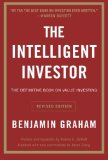Stock selection for the defensive investor
Benjamin Graham (1894-1976), the father of value investing, said in his widely-followed book, The Intelligent Investor, that one choice for the defensive investor in stock selection would be to apply a set of standards to each purchase, to make sure that he obtains (i) a minimum of quality in the past performance and current financial position of the company and (ii) a minimum of quantity in terms of earnings and assets per dollar of price.
He suggested seven such quality and quantity criteria for the selection of specific common stocks by the defensive investor.
A defensive (or passive) investor, according to Benjamin Graham, would place his chief emphasis on the avoidance of serious mistakes or losses. The defensive investor’s second aim would be “freedom from effort, annoyance, and the need for making frequent decisions”.
Here are the seven quality and quantiy criteria he listed for stock selection by a defensive investor:
1. Adequate Size of the Enterprise
The idea is to exclude small companies which may be subject to more than average vicissitudes especially in the industrial field.
Not less than US$100 million of annual sales for an industrial company and, not less than US$50 million of total assets for a public utility.
(Note: These figures in 2015 were approximately US$600 million and US$300 million respectively. Veteran investment writer Jason Zweig in his accompanying commentary for Benjamin Graham’s The Intelligent Investor, Chapter 14 said: “Nowadays, “to exclude small companies,” most defensive investors should steer clear of stocks with a total market value of less than US$2 billion.” Jason Zweig also said: “However, today’s defensive investors – unlike those in Graham’s days – can conveniently own small companies by buying a mutual fund specializing in small stocks.”).
2. A Sufficiently Strong Financial Condition
According to Benjamin Graham, for industrial companies, current assets should be at least twice current liabilities – a so-called two-to-one current ratio. Also, long-term debt should not exceed the net current assets (or working capital). For public utilities, the debt should not exceed twice the stock equity (at book value).
3. Earnings Stability

Some earnings for the common stock in each of the past ten years.
4. Dividend Record
Uninterrupted payments for at least the past 20 years.
5. Earnings Growth
A minimum increase of at least one-third in per-share earnings in the past ten years using three-year averages at the beginning and end.
6. Moderate Price/Earnings Ratio
Current price should not be more than 15 times average earnings of the past three years.
7. Moderate Ratio of Price to Assets
Benjamin Graham said that current price should not be more than 1.5 times the book value last reported. However, a multiplier of earnings below 15 could justify a correspondingly higher multiplier of assets. “As a rule of thumb,” he said, “we suggest that the product of the multiplier times the ratio of price to book value should not exceed 22.5 (this figure corresponds to 15 times earnings and 1.5 times book value. It would admit an issue selling at only 9 times earnings and 2.5 times asset value, etc.).”